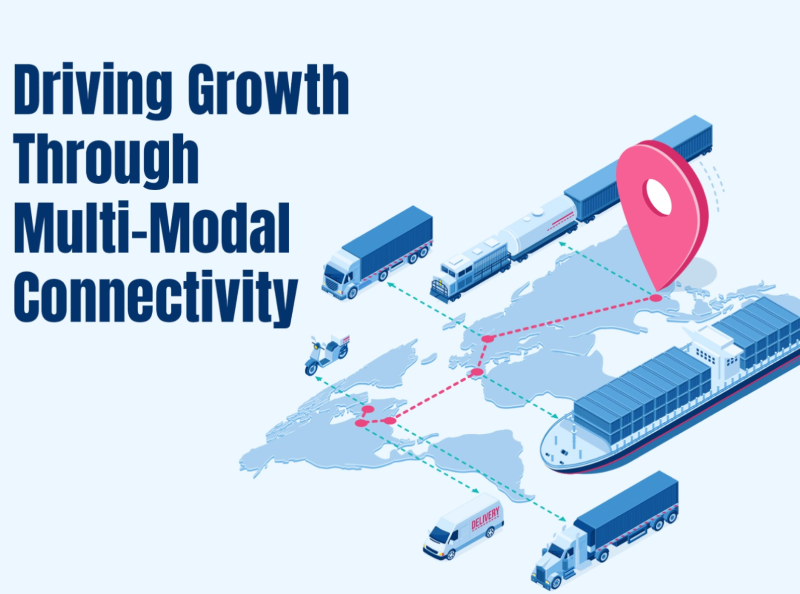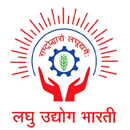The Road Ahead
How Multi-Modal Logistics Parks Are Shaping
Uttar Pradesh’s Future
Until recently, driving down a highway in Uttar Pradesh, ‘India’s most populous state’ meant navigating through a web of challenges. Endless trucks carrying everything from farm produce to industrial goods often got caught in bottlenecks, slowed down by outdated infrastructure and inefficient routes. It was a picture of India’s logistics landscape – vast and vital, yet burdened by inefficiencies that held back its true potential.
But that picture is changing, fast.
Uttar Pradesh is turning these challenges into opportunities through the development of Multi-Modal Logistics Hubs (MMLH) and Multi-Modal Transport Hubs (MMTH) in Greater Noida. Designed to ensure smooth movement of goods and passengers across rail, road, and mass rapid transit systems, these projects are strategically connected to the Eastern and Western Dedicated Freight Corridors and major expressways. Together, they’re making transportation faster, more efficient, and sustainable, while fuelling economic growth and job creation across the region.
At the core of this transformation lies the Multi-Modal Logistics Park (MMLP) Policy 2024, a visionary step by the state to redefine the way goods move within and beyond Uttar Pradesh. More than just warehouses or cargo yards, these are smart, interconnected logistics ecosystems, where freight moves seamlessly across rail, road, air, and sea. The result? A stronger, greener, and more connected Uttar Pradesh, leading India’s logistics revolution.
Transforming Logistics with Multi-Modal Hubs
Multi-Modal Logistics Parks (MMLPs) represent a transformative step towards building an efficient and integrated logistics ecosystem in India. MMLPs aren’t just about physical space; they represent a massive shift towards efficiency. These integrated hubs are designed to allow seamless transfers between various modes of transport. Imagine a truck driving in, unloading goods, and within hours, those same goods are transferred to a train, then to a ship, and then finally to their destination, all with minimal handling and delays. That’s the magic of MMLPs.
These parks offer much more than just storage. They provide mechanized warehouses, cold storage, specialized storage solutions, and even value-added services like customs clearance, testing facilities, and packaging. It’s not just about moving goods, it’s about moving them efficiently, saving time, reducing costs, and lowering carbon emissions.
The Multi-Modal Solution and Uttar Pradesh’s Big Bet
Here’s where Multi-Modal Logistics Parks (MMLPs) come in and Uttar Pradesh is not just watching from the side-lines, it’s stepping up to lead.
MMLPs are not your average warehouses. Think of them as integrated logistics super hubs, where goods switch seamlessly between rail, road, air, and water transport, all within one facility. We’re talking:
- Mechanized, smart warehousing
- Cold storage and specialized cargo handling
- Intermodal freight terminals
- Customs clearance, value-added services, and even late-stage manufacturing like sorting, labelling, and packaging
And guess what? Uttar Pradesh has a game plan. Under its Multi-Modal Logistics Park Policy 2024(https://invest.up.gov.in/uttar-pradesh-multi-modal-logistics-park-policy-2024/), the state is going full throttle with targeted incentives to attract mega-investments in logistics.
Policy with a Purpose: Uttar Pradesh’s Competitive Edge
One of the most compelling advantages of Multi-Modal Logistics Parks (MMLPs) is their ability to significantly reduce logistics costs. The Indian government, under initiatives like the Bharatmala Project, is actively promoting the development of these transformative hubs. But Uttar Pradesh is going a step further with its own dedicated ‘Multi-Modal Logistics Policy 2024′(https://invest.up.gov.in/uttar-pradesh-multi-modal-logistics-park-policy-2024/), a move that is both ambitious and strategically essential for the state’s growth.
Here’s what Uttar Pradesh is offering to investors who are ready to take the leap:
- 30% upfront land subsidyState-allotted industrial land parcels
- Nodal agency support from Invest UP
- Infrastructure supportfor seamless last-mile connectivity—rail, road, and air
Additionally, a Multi-Modal Logistics Hub (MMLH) at Dadri and a Multi-Modal Transport Hub (MMTH) at Boraki are under development to further strengthen the state’s logistics infrastructure and connectivity network.
This bold move not only aligns with national initiatives but also gives Uttar Pradesh a competitive edge in attracting investment and fostering a more efficient logistics ecosystem.
MMLPs are set to integrate various modes of transport, making freight movement faster, more efficient, and cost-effective. The expected reduction in transportation costs could be a game-changer when you consider India’s massive logistics spend.
But the benefits don’t end there. MMLPs also promise to tackle urban congestion. By relocating warehouses and wholesale markets to suburban areas closer to these hubs, the state can reduce traffic, lower pollution, and create more liveable urban spaces.
Plus, the environmental impact cannot be overstated — optimizing transportation and warehousing will lead to a notable reduction in carbon emissions, paving the way for a greener and more sustainable future.
Following Global Footsteps with a Local Twist
What Uttar Pradesh is doing isn’t unprecedented, the world is already on board.
- The United States of America is pumping billions into logistics hubs under its Infrastructure Investment and Jobs Act.
- The European Union has funded Multi-Modal corridors through Connecting Europe Facilities (CEF) and Trans-European Transport Network (TEN-T).
- China, Russia, and Brazil are giving land, tax breaks, and state support for MMLPs
- Dubai has seamlessly integrated sea-air-road freight systems.
However, Uttar Pradesh is taking a strategic approach by leveraging global best practices and adapting them to its unique geographic, economic, and infrastructural landscape.
With its strategic location, rapidly developing industrial zones, vast consumer base, and strong connectivity through the Eastern and Western Dedicated Freight Corridors, Uttar Pradesh is exceptionally well-positioned to turn Multi-Modal Logistics Parks (MMLPs) into a resounding success. The WDFC, passing through western UP, supports projects in Greater Noida, Dadri, and Noida-Ghaziabad, while the EDFC drives industrial growth in eastern UP, with clusters in Auraiya, Kannauj-Kanpur, Prayagraj-Varanasi, and Agra-Aligarh, collectively making the state a key logistics and business hub.
Uttar Pradesh’s Multi-Modal Hubs: A Game Changer for Trade and Transport
Taking the MMLP vision a step further, Uttar Pradesh is rolling out its own state-of-the-art Multi-Modal Logistics Hub (MMLH) and Multi-Modal Transport Hub (MMTH) in Greater Noida. The Special Purpose Vehicle (SPV) of Integrated Industrial Township – Greater Noida is the implementation agency for these projects, with connectivity approved ‘in principle’ by the Dedicated Freight Corridor Corporation of India Limited (DFCCIL). Currently, 84% of the land is in possession of the state government, while remaining parcels are being acquired swiftly.
Strategically located near the Eastern Peripheral Expressway, NH 91, Noida-Greater Noida Expressway, Yamuna Expressway, and both the Eastern & Western Dedicated Freight Corridors, these hubs will serve as world-class logistics and transport centers. The MMLH will handle efficient storage and transfer of goods to and from the Dedicated Freight Corridors, offering value-added services such as container handling, packaging, and cargo optimization to reduce logistics costs and improve operational efficiency.
The MMTH near Boraki Railway Station is designed to be a seamless passenger transport hub with access to rail, road, and mass rapid transit systems (MRTS). It will feature an Inter-State Bus Terminal (ISBT), Local Bus Terminal (LBT), metro connectivity, commercial and retail spaces, hotel facilities, and green open spaces. These projects are expected to generate around 1 lakh jobs by 2040 and will drive growth in the surrounding region while helping decongest Delhi.
Together, the MMLH and MMTH exemplify Uttar Pradesh’s commitment to modern, integrated logistics and transport infrastructure, making the state a true central hub for freight and passenger movement across northern India.
Driving Growth through MMLPs
Uttar Pradesh, through its Multi-Modal Logistics Park Policy 2024, is taking proactive steps to strengthen large-scale logistics infrastructure. With a clear focus on attracting investment, the state is offering a range of incentives such as land subsidies, interest subsidies, and capital subsidies. Projects with a minimum investment of ₹1000 crore are eligible for these benefits, including a 30% upfront land subsidy that helps ease the initial financial burden and makes investments in MMLPs more attractive and sustainable.
This combination of policy support and incentives creates a fertile ground for investment, overcoming the initial challenges and ushering in a more efficient, cost-effective logistics ecosystem for Uttar Pradesh and beyond.
A Greener, Smarter, More Competitive Uttar Pradesh
There’s also the sustainability angle.
By shifting from road-heavy freight to multi-modal transport, MMLPs can slash fuel consumption, reduce carbon emissions, and unclog city roads. UP’s policy also promotes suburban logistics parks, which could help decongest cities like Lucknow, Kanpur, and Ghaziabad, while bringing development to tier-2 and tier-3 towns.
Add smart storage, waste treatment facilities, and green space development and you’ve got future-ready logistics infrastructure.
The Road Ahead
Looking ahead, the development of Multi-Modal Logistics Parks (MMLPs) promises to significantly enhance the efficiency of India’s logistics sector, driving down costs, boosting competitiveness, and accelerating economic growth. As infrastructure expands, freight movement becomes faster, and technology takes center stage, India is well-positioned to emerge as a global logistics powerhouse.
In Uttar Pradesh, key projects like the Multi-Modal Logistics Hub (MMLH) and Multi-Modal Transport Hub (MMTH) in Greater Noida exemplify this vision in action. These world-class facilities are redefining how goods and passengers move, seamlessly integrating rail, road, and mass rapid transit systems, while fostering industrial development, employment, and regional connectivity. Together with the Multi-Modal Logistics Park (MMLP) Policy 2024, they form the cornerstone of a modern, efficient, and sustainable logistics ecosystem in the state.
Of course, the path ahead will require coordinated efforts among government agencies, private players, and local communities. Embracing digitalization, automation, and skill development will be crucial to ensure that MMLPs, MMLH, and MMTH operate at peak efficiency and deliver long-term economic benefits.
As this network expands across India, the vision is clear, a streamlined, cost-effective, and sustainable logistics framework that not only strengthens India’s domestic supply chains but also redefines its role in global trade. With projects like those in Uttar Pradesh leading the charge, the road ahead isn’t just about connectivity; it’s about transforming how India moves.
To know more about other sector policies click (https://invest.up.gov.in/policies/)
To know more about Invest UP click (https://invest.up.gov.in/)
Uttar Pradesh — where India’s logistics future is being built, one park at a time.
*******



























